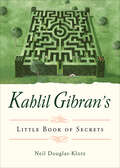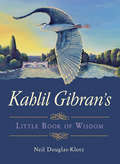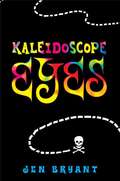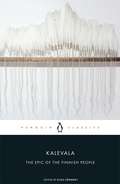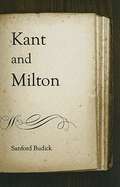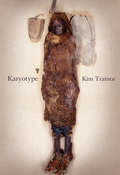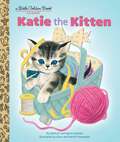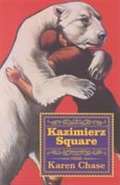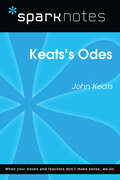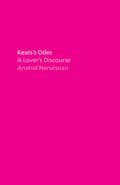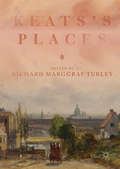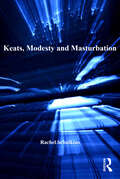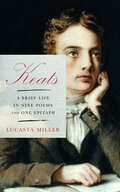- Table View
- List View
Kahlil Gibran's Little Book of Secrets
by Kahlil Gibran Neil Douglas-KlotzOne of the most popular and profound inspirational writers of all time explores the mysteries of life. Here is bite-sized wisdom for daily living in a beautiful gift package.This book is a collection of Gibran's words on life's big questions and the mysteries of the spiritual path. It is an exploration of the riddles and conundrums that are part of the fabric of existence, and it is an attempt to penetrate and explain the mysteries of life.Gibran was fascinated by life's puzzles and riddles--those questions that cause us to stop what we are doing and ask, "Why?" Here are his musings about the seemingly unanswerable questions and his exploration of good and evil, love and hate, and the difference between appearances and reality.Kahlil Gibran's Little Book of Secrets is organized into five sections that elucidate the key issues and questions that each of us face:1.Entering the Labyrinth of Life2.Secrets of Life and Death3.Life's Ups and Downs4.Secrets of Good and Evil5.Traveling the Inner PathThis inspirational gift volume gently guides readers through life's big issues: meaning and mortality, good and evil, and discovering an authentic spiritual path. Suitable for all gift-giving occasions, it is a book that delights, informs, and inspires.
Kahlil Gibran's Little Book of Wisdom
by Kahlil GibranOne of the most popular and profound inspirational writers of all time shares simple wisdom for living a happy and fulfilling life. <P><P>This book is a collection of Gibran's words on how to live. Here are his thoughts on what it means to live in community and solitude and what gives life meaning, along with his often prescient views on government, organized religion, wealth, and commerce. Gibran's sensibility feels contemporary. He did not recognize any ultimate authority outside of the human soul: <P><P>"It were wiser to speak less of God, whom we cannot understand and more of each other, whom we may understand." <P><P>This is the essential Gibran, with 88 selections organized into 5 sections that elucidate answers to the questions that each of us face: <P><P>Living a Wise Life <P><P>Community Wisdom Wise Exchange Wisdom from Solitude Wisdom Beyond Words <P><P>This inspirational gift volume gently guides readers through life’s big issues: meaning and mortality, good and evil, and discovering an authentic spiritual path. <P><P> Suitable for all gift-giving occasions, it is a book that delights, informs, and inspires.
Kalanni Nidra Ponivvanu (I Will Not Let Time Sleep)
by N. Gopi J. BhagyalakshmiWork of N. Gopi translated by J. Bhagyalakshmi. Award winning collection of Telugu poems.
Kaleidoscope Eyes
by Jennifer BryantIn 1968, while the Vietnam War rages, thirteen-year-old Lyza inherits a project from her deceased grandfather, who was using his knowledge of maps and the geography of Lyza's New Jersey hometown to locate the lost treasure of Captain Kidd.
Kalevala: The Epic of the Finnish People
by Elias Lönnrot'One of the great mythic poems of Europe' The New York TimesSharing its title with the poetic name for Finland - 'the land of heroes' - Kalevala is the soaring epic poem of its people, a work rich in magic and myth which tells the story of a nation through the ages from the dawn of creation. Sung by rural Finns since prehistoric times, and formally compiled by Elias Lönnrot in the nineteenth century, it is a landmark of Finnish culture and played a vital role in galvanizing its national identity in the decades leading to independence. Its themes, however, reach beyond borders and search the heart of human existence.Translated with an Introduction by Eino Friberg
Kalyana Mittata: Beautiful Friendship Poems
by Basil FernandoFernando may not write a lot, but his poems are moving and powerful. This collection includes: The Anonymous People, The Tortoise and the Philosopher, Gems and Intrigue, Sweet Are the Blessings, and more. "Resurrection Today I talked to a man Who had escaped A death camp. Resurrection? No, He is dying now. Growing thin Looking dazed and haggard Having nightmares Mentally not all there. Typical signs Of those who undergo Such experiences," says the psychiatrist. Is there any typical sign To know what His torturers go through? Sweet dreams, nice children Great hopes? I could have helped This man to escape The dreaded camp. I am powerless now, To prevent his slow death."
Kamayani
by Jayshankar PrasadKamayani looks at the Chayawaadi school of Hindi poetry. It plays continuously with the human emotions and takes metaphors from mythologies. The chapters even are named after the emotions. The plot is based on the Vedic story where Manu, the man surviving after the deluge (Pralaya), is emotionless (Bhavanasunya). Anyone having interest in Hindi poetry must read it.
Kamban
by S. MaharajanThe characteristic reach of the Poet Kamban for cosmic personification in his poetry clearly ties these high and abstract matters to very human detail. It is the world of human experience he deals with, and it is through the exaltation of poetic song that he achieves what all the world's great poetry attempts to achieve--a marriage of the divine and timeless with the earthly and experiential.
Kandar Anubuthi, Kandar Alangaram,Vel/Mayil/Seval Viruttham and Tiruvakuppu of Arunagiri Nathar
by Arunagiri NatharKandar Anubhuthi: In this composition of 51 verses the poet, in his inimitable style of ‘sandham’(Tune), worships Lord Murugan for protection and salvation. Kandar Alangaram: Arunagirinathar offers his favourite deity God Murugan not a garland of flowers (poomalai), but a garland of songs (paamalai) in 107 verses. It describes the different manifestations of Muruga in each temple and how He showers mercy on the devotees. Vel –Mayil-Seval Virutham: Vel is a sharp Weapon adorning the hand of God Murugan, Mayil (Peacock) is His Vehicle (Vahana) and Seval (Rooster) is His Flag. Virutham is the tempo of the lyrics. Arunagirinathar glorifies the three- Vel, Mayil and Seval, each in six viruthams.Vel is a symbol of intellect, Mayil represents splendor and majesty and Seval wakes up people from darkness to dawn.
Kant and Milton
by Sanford BudickThis book brings to bear new evidence and long-neglected materials to show the importance of Kant's encounter with Milton's poetry to the formation of Kant's moral and aesthetic thought.
Kapilar Akaval
by KapiladevarAkaval ia a poetic form. In this poem Kapilar narrates the mortality of life and emphasizes all are equal by birth and no one is superior by birth alone.
Kareem Between
by Shifa Saltagi Safadi**WINNER of the NATIONAL BOOK AWARD for Young People's Literature**This heartfelt coming-of-age novel in verse tells the powerful story of a seventh-grade Syrian American boy and his struggles, big and small, as he navigates middle school."The exact type of book I would've loved, and needed, as a kid." — Jasmine Warga, New York Times bestselling author of and Newbery Honor recipient for Other Words for HomeSeventh grade begins, and Kareem&’s already fumbled it. His best friend moved away, he messed up his tryout for the football team, and because of his heritage, he was voluntold to show the new kid—a Syrian refugee with a thick and embarrassing accent—around school. Just when Kareem thinks his middle school life has imploded, the hotshot QB promises to get Kareem another tryout for the squad. There&’s a catch: to secure that chance, Kareem must do something he knows is wrong.Then, like a surprise blitz, Kareem&’s mom returns to Syria to help her family but can&’t make it back home. If Kareem could throw a penalty flag on the fouls of his school and home life, it would be for unnecessary roughness.Kareem is stuck between. Between countries. Between friends, between football, between parents—and between right and wrong. It&’s up to him to step up, find his confidence, and navigate the beauty and hope found somewhere in the middle.
Karma
by Cathy OstlereIt is 1984, and fifteen-year-old Maya is on her way to India with her father. She carries with her the ashes of her mother, who has recently committed suicide, and arrives in Delhi on the eve of Prime Minister Indira Gandhi's assassination - one of the bloodiest riots in the country's history. <P><P>Then Maya is separated from her father and must rely upon the help of a mysterious, kindhearted boy, Sandeep, to safely reunite them. But as her love for Sandeep begins to blossom, Maya will have to face the truth about her painful adolescence . . . if she's ever to imagine her future. <P><P>In this gorgeous, haunting portrait of love, loss, and growing up, Cathy Ostlere - in masterful strokes of verse - has created a simply unforgettable read.
Karyotype
by Kim TrainorAt the heart of Karyotype is the Beauty of Loulan, a woman who lived four thousand years ago, her body preserved in the cool, dry sands of the Taklamakan Desert. Karyotype’s poems range from the title sequence, which explores the DNA and woven textiles of this woman and her vanished people (a karyotype is the characteristic chromosome complement of a species), to the firebombing of the National Library of Sarajevo, from an abecedarian hymn on the International Red Cross “Book of Belongings” to the experience of watching the televised invasion of Iraq in the dark of a Montreal night. The Beauty of Loulan becomes a symbol of the ephemerality of human genetic and cultural texts, and of our chances for survival.
Kashmiri Lyrics
by Neerja Mattoo J. L. KaulAmin Kamil (1924-) is a major voice in poetry of the Kashmiri language. Revised & edited by Neerja Mattoo, translated by J. L. Kaul.
Katie the Kitten (Little Golden Book)
by Kathryn Jackson Byron JacksonBack in print after more than 60 years, a heartwarming tale for today's kitten-loving kids—from the author of the iconic Little Golden Books Tawny Scrawny Lion and The Saggy Baggy Elephant!First published in 1949—and now finally back in print—this charming story about a kitten beginning to make her way around the house will become a family favorite. Breathtaking artwork by Alice and Martin Provensen, who also illustrated The Color Kittens, has been lovingly restored for this edition.
Katrina
by Lyn LifshinAs August 2010, the fifth anniversary of Hurricane Katrina, approaches, Lifshin's volume of straightforward, exact poetry reflects a sense of loss, grief, and compassion.
Kavya Pradeep Class 11
by Suryanarayan RanshubheThis is collection of hindi poems from 1910 to 2010 for students of class eleven of Maharastra education board.
Kazimierz Square
by Karen ChasePainting and photography are things Karen Chase does well; so are fishing and cooking. I never met anyone quite so vividly and rewardingly at home with putting together a meal.
Keats's Odes (SparkNotes Literature Guide Series)
by SparkNotesKeats's Odes (SparkNotes Literature Guide) by John Keats Making the reading experience fun! Created by Harvard students for students everywhere, SparkNotes is a new breed of study guide: smarter, better, faster. Geared to what today's students need to know, SparkNotes provides: *Chapter-by-chapter analysis *Explanations of key themes, motifs, and symbols *A review quiz and essay topicsLively and accessible, these guides are perfect for late-night studying and writing papers
Keats's Odes: A Lover's Discourse
by Anahid Nersessian“When I say this book is a love story, I mean it is about things that cannot be gotten over—like this world, and some of the people in it.” In 1819, the poet John Keats wrote six poems that would become known as the Great Odes. Some of them—“Ode to a Nightingale,” “To Autumn”—are among the most celebrated poems in the English language. Anahid Nersessian here collects and elucidates each of the odes and offers a meditative, personal essay in response to each, revealing why these poems still have so much to say to us, especially in a time of ongoing political crisis. Her Keats is an unflinching antagonist of modern life—of capitalism, of the British Empire, of the destruction of the planet—as well as a passionate idealist for whom every poem is a love poem. The book emerges from Nersessian’s lifelong attachment to Keats’s poetry; but more, it “is a love story: between me and Keats, and not just Keats.” Drawing on experiences from her own life, Nersessian celebrates Keats even as she grieves him and counts her own losses—and Nersessian, like Keats, has a passionate awareness of the reality of human suffering, but also a willingness to explore the possibility that the world, at least, could still be saved. Intimate and speculative, this brilliant mix of the poetic and the personal will find its home among the numerous fans of Keats’s enduring work.
Keats's Places
by Richard Marggraf TurleyAs the essays in this volume reveal, Keats’s places could be comforting, familiar, grounding sites, but they were also shifting, uncanny, paradoxical spaces where the geographical comes into tension with the familial, the touristic with the medical, the metropolitan with the archipelagic. Collectively, the chapters in Keats’s Places range from the claustrophobic stands of Guy’s Hospital operating theatre to the boneshaking interior of the Southampton mail coach; from Highland crags to Hampstead Heath; from crowded city interiors to leafy suburban lanes. Offering new insights into the complex registrations of place and the poetic imagination, the contributors to this book explore how the significant places in John Keats’s life helped to shape an authorial identity.
Keats, Modesty and Masturbation
by Rachel SchulkinsExamining John Keats’s reworking of the romance genre, Rachel Schulkins argues that he is responding to and critiquing the ideals of feminine modesty and asexual femininity advocated in the early nineteenth century. Through close readings of Isabella; or the Pot of Basil, The Eve of St. Agnes, Lamia and ’La Belle Dame sans Merci,’ Schulkins offers a re-evaluation of Keats and his poetry designed to demonstrate that Keats’s sexual imagery counters conservative morality by encoding taboo desires and the pleasures of masturbation. In so doing, Keats presents a version of female sexuality that undermines the conventional notion of the asexual female. Schulkins engages with feminist criticism that largely views Keats as a misogynist poet who is threatened by the female’s overwhelming sexual and creative presence. Such criticism, Schulkins shows, tends towards a problematic identification between poet and protagonist, with the text seen as a direct rendering of authorial ideology. Such an interpretation neither distinguishes between author, protagonist, text, social norms and cultural history nor recognises the socio-sexual and political undertones embedded in Keats’s rendering of the female. Ultimately, Schulkins’s book reveals how Keats’s sexual politics and his refutation of the asexual female model fed the design, plot and vocabulary of his romances.
Keats: A Brief Life in Nine Poems and One Epitaph
by Lucasta MillerA dazzling new look into the short but intense, tragic life and remarkable work of John Keats, one of the greatest lyric poets of the English language, seen in a whole new light, not as the mythologized Victorian guileless nature-lover, but as the subversive, bawdy complex cynic whose life and poetry were lived and created on the edge.In this brief life, acclaimed biographer Lucasta Miller takes nine of Keats's best-known poems—"Endymion"; "On First Looking into Chapman&’s Homer"; "Ode to a Nightingale"; "To Autumn"; "Bright Star" among them—and excavates how they came to be and what in Keats's life led to their creation. She writes of aspects of Keats's life that have been overlooked, and explores his imagination in the context of his world and experience, paying tribute to the unique quality of his mind. Miller, through Keats&’s poetry, brilliantly resurrects and brings vividly to life, the man, the poet in all his complexity and spirit, living dangerously, disdaining respectability and cultural norms, and embracing subversive politics. Keats was a lower-middle-class outsider from a tragic and fractured family, whose extraordinary energy and love of language allowed him to pummel his way into the heart of English literature; a freethinker and a liberal at a time of repression, who delighted in the sensation of the moment. We see how Keats was regarded by his contemporaries (his writing was seen as smutty) and how the young poet&’s large and boisterous life—a man of the metropolis, who took drugs, was sexually reckless and afflicted with syphilis—went straight up against the Victorian moral grain; and Miller makes clear why his writing—considered marginal and avant-garde in his own day—retains its astonishing originality, sensuousness and power two centuries on.
